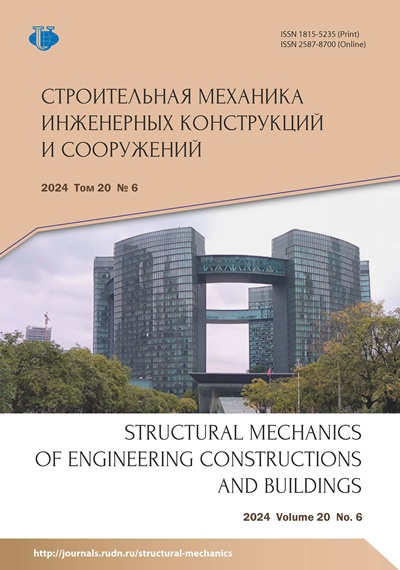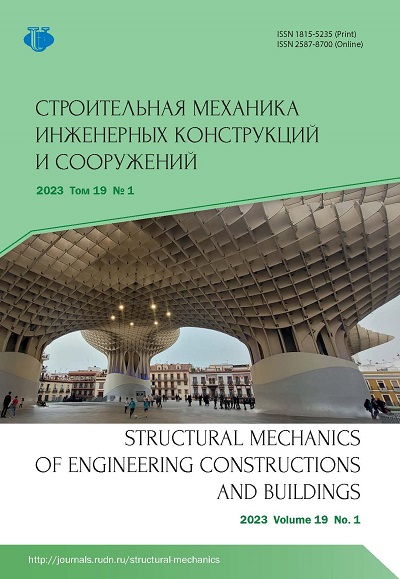Modal analysis of a large-span building with different boundary conditions
- Authors: Kuzhakhmetova E.R.1, Sutyrin V.I.2
-
Affiliations:
- Moscow State University of Civil Engineering (National Research University)
- Immanuel Kant Baltic Federal University
- Issue: Vol 19, No 1 (2023)
- Pages: 17-34
- Section: Analysis and design of building structures
- URL: https://journals.rudn.ru/structural-mechanics/article/view/34419
- DOI: https://doi.org/10.22363/1815-5235-2023-19-1-17-34
- EDN: https://elibrary.ru/FMMJZM
Cite item
Full Text
Abstract
The authors present the results of a modal analysis of finite element models of a large-span building with a cylindrical-and-slab roof as a large mechanical system. During the numerical study, the following spatial models are considered: 1) superstructure - fixed-end; 2) superstructure - pile foundation - soil base. The purpose of the study is to compare the results of a modal analysis of the design of a large-span building with different boundary conditions, physical and mechanical properties of the soil base. Modal analysis of a large-span building with a cylindrical-and-slab roof was carried out using the Femap NX Nastran CAE-class software package implementing the finite element method. The authors compare the frequencies and modes of natural oscillations of the construction of spatial models obtained on models of types 1 and 2 of the large-span building with a cylindrical-and-slab roof. As a result of the modal analysis of model 2, the influence of the physical and mechanical properties of the soil base on the characteristics of the structure's own oscillation was revealed. In the prospect, it is proposed to conduct a dynamic analysis of a large-span building with a cylindrical-and-slab roof for seismic effects.
About the authors
Elvira R. Kuzhakhmetova
Moscow State University of Civil Engineering (National Research University)
Author for correspondence.
Email: elja_09@bk.ru
ORCID iD: 0000-0002-0907-786X
SPIN-code: 1949-1140
engineer, senior lecturer, Reinforced Concrete Structures and Masonry Structures Department, Institute of Industrial and Civil Engineering
26 Yaroslavskoye Shosse, Moscow, 129377, Russian FederationValerii I. Sutyrin
Immanuel Kant Baltic Federal University
Email: vsutyrin@mail.ru
ORCID iD: 0000-0002-4911-8515
SPIN-code: 7194-7481
Doctor of Technical Sciences, Professor, Head of the Institute of Engineering and Technology
14 Aleksandra Nevskogo St, Kaliningrad, 236041, Russian FederationReferences
- Kuzhakhmetova E.R., Sapozhnikov A.I. Architectural expressiveness and physiological expediency of buildings with curvilinear surfaces. Building Materials, Equipment, Technologies of the 21st Century. 2012;11(166):42–45. (In Russ.)
- Sapozhnikov A.I. The life of buildings in the earth element. LAP Lamber Academic Publishing; 2014. (In Russ.)
- Vinogradov G.G. Calculation of building spatial structures. Leningrad: Stroiizdat Publ.; 1990. (In Russ.)
- Zimin S.S., Bespalov V.V., Kokotkova O.D. Vault structures of historical buildings. Construction of Unique Buildings and Structures. 2015;(2):57–72. (In Russ.)
- Mamieva I.A. Analytical surfaces for parametric architecture in contemporary buildings and structures. Academia. Architecture and Construction. 2020;(1):150‒165. (In Russ.)
- Mamieva I.A. Analytical surfaces in the architecture of Moscow. Structural Mechanics of Engineering Constructions and Buildings. 2013;(4):9‒15. (In Russ.)
- Krivoshapko S.N., Mamieva I.A. Umbrella surfaces and surfaces of umbrella type in architecture. Industrial and Civil Construction. 2011;(7‒1): 27‒30. (In Russ.)
- Krivoshapko S.N., Alborova L.A., Mamieva I.A. Shell structures: genesis, materials and subtypes. Part 1. Subtypes and directions. Academia. Architecture and Construction. 2021;(3):125‒134. (In Russ.) http://doi.org/10.22337/2077-9038-2021-3-125-134
- Krivoshapko S.N., Alborova L.A., Mamieva I.A. Shell structures: genesis, materials and subtypes. Part 2. Constructive building materials Academia. Architecture and Construction. 2021;(4):110‒119. (In Russ.) http://doi.org/10.22337/2077-9038-2021-4-110-119
- Kuzhakhmetova E.R. Features of the stress-strain state of a building with a cylinder-plate-cable-stayed coating. Topical Issues of Modern Science: A Collection of Articles Based on the Materials of the XII International Scientific and Practical Conference, Tomsk, 23 May 2018 (part 1). Tomsk: Dendra Publ.; 2018. p. 93–98. (In Russ.)
- Park K., Park M., Shin S. Design of large space cable roofs with retractable systems to open and close. International Journal of Latest Trends in Engineering and Technology. 2017;8(4–1):197–203. http://doi.org/10.21172/1.841.34
- Grunwalda G., Hermekingb T., Prangc T. Kinetic roof structure: Msheireb Heart of Doha. Procedia Engineering. 2016;(155):289–296. http://doi.org/10.1016/j.proeng.2016.08.031
- Kuzhakhmetova E.R. Numerical design of frame buildings taking into account the generalized stiffness and load of soil and foundation. Bulletin of BSTU named after V.G. Shukhov. 2019;(12):34–46. (In Russ.) http://doi.org/10.34031/2071-7318-2019-4-12-34-46
- Popova A., Strakhov D., Sinyakov L. Numerical analysis of ground-structure interaction for framed building with isolated footings. Lecture Notes in Civil Engineering. 2021;150:304‒315. https://doi.org/10.1007/978-3-030-72404-7_30
- Chandiwala A., Savaliya M., Vasanwala S. Soil – structure interaction on pile raft foundation in multi-story RC building with vertical irregularity. Lecture Notes in Civil Engineering. 2021;138:437‒445.
- Mirsayapov I., Shakirov I., Nurieva D. Numerical studies of soil base deformations from reconstructed multi-storey building to nearby buildings. E3S Web of Conferences. 2021;274. https://doi.org/10.1051/e3sconf/202127403020
- Wang H., Zhang R. Dynamic structure-soil-structure interaction of piled high-rise buildings under earthquake excitations I: influence on dynamic response. Latin American Journal of Solids and Structures. 2021;18(3):e357. https://doi.org/10.1590/1679-78256223
- Wu M. Analysis of the influence of pile foundation settlement of high-rise buildings on surrounding buildings. Arabian Journal of Geosciences. 2020;13(822). https://doi.org/10.1007/s12517-020-05832-7
- Bhattacharjee T., Chanda D., Saha R. Influence of soil flexibility and plan asymmetry on seismic behaviour of soil-piled raft-structure system. Structures. 2021;33:1775‒1788. https://doi.org/10.1016/j.istruc.2021.05.045
- Baimakhan R.B., Kadirova Z.B., Seinassinova A.A., Baimakhan A.R., Baimakhanova G.M. Calculation model of the “building-foundation” system on anisotropic base and deformation calculations. Periodicals of Engineering and Natural Sciences. 2021;9(1):308‒321. http://doi.org/10.21533/pen.v9i1.1807
- Mirsayapov I., Koroleva I. Long-term settlements assessment of high-rise building groundbase based on analytical ground deformation diagram. Procedia Engineering. 2016;165:519‒527. https://doi.org/10.1016/j.proeng.2016.11.728
- Khoshnoudian F., Ziaei R., Ayyobi P. Effects of nonlinear soil – structure interaction on the seismic response of structure-TMD systems subjected to near-field earthquakes. Bulletin of Earthquake Engineering. 2017;15:199–226. https://doi.org/10.1007/s10518-016-9963-y
- Gentile C., Guidobaldi M., Saisi A. One-year dynamic monitoring of a historic tower: damage detection under changing environment. Meccanica. 2016;51:2873–2889. https://doi.org/10.1007/s11012-016-0482-3
- Ubertini F., Cavalagli N., Kita A. Assessment of a monumental masonry bell-tower after 2016 Central Italy seismic sequence by long-term SHM. Bulletin of Earthquake Engineering. 2018;16:775–801. https://doi.org/10.1007/s10518-017-0222-7
- Azzara R.M., Girardi M., Padovani C., Pellegrini D. Experimental and numerical investigations on the seismic behaviour of the San Frediano bell tower in Lucca. Annals of Geophysics. 2019;62(3):SE342. https://doi.org/10.4401/ag-8025
- Cuadra C., Karkee M.B., Tokeshi K. Earthquake risk to Inca’s historical constructions in Machupicchu. Advances in Engineering Software. 2008;39(4):336‒345. https://doi.org/10.1016/j.advengsoft.2007.01.002
- Karapetroa S., Manakou M., Bindi D., Petrovic B., Pitilakis K. “Time-building specific” seismic vulnerability assessment of a hospital RC building using field monitoring data. Engineering Structures. 2016;112(1):114‒132. https://doi.org/10.1016/j.engstruct.2016.01.009
- Karatzetzou A., Pitilakis D. Reduction factors to evaluate acceleration demand of soil-foundation-structure systems. Soil Dynamics and Earthquake Engineering. 2018;109:199‒208. https://doi.org/10.1016/j.soildyn.2018.03.017
- Karafagka S., Fotopoulou S., Pitilakis D. Fragility assessment of non-ductile RC frame buildings exposed to combined ground shaking and soil liquefaction considering SSI. Engineering Structures. 2021;229(15):111629. https://doi.org/10.1016/j.engstruct.2020.111629
- Forcellini D., Giardi F., Tanganelli M. Seismic assessment of the historical third tower in San Marino based on a 3D laser scanner survey (3D-LSS). Innovative Infrastructure Solutions 2019;4(20). https://doi.org/10.1007/s41062-019-0207-2
- Forcellini D. Analytical fragility curves of shallow-founded structures subjected to soil-structure interaction (SSI) effects. Soil Dynamics and Earthquake Engineering. 2021;41:106487. https://doi.org/10.1016/j.soildyn.2020.106487
- Cavalieri F., Correia A.A., Crowley H. Seismic fragility analysis of URM buildings founded on piles: influence of dynamic soil – structure interaction models. Bulletin of Earthquake Engineering. 2020;18:4127–4156. https://doi.org/10.1007/s10518-020-00853-9
- Cavalieri F., Correia A.A., Crowley H., Pinho R. Seismic fragility analysis of URM buildings founded on piles: influence of dynamic soil – structure interaction models. Bulletin of Earthquake Engineering. 2020;18:4127–4156. https://doi.org/10.1007/s10518-020-00853-9
- Ashayeri I., Biglari M., Formisano A., D'Amatoc M. Ambient vibration testing and empirical relation for natural period of historical mosques. Case study of eight mosques in Kermanshah, Iran. Construction and Building Materials. 2021;289:123191. https://doi.org/10.1016/j.conbuildmat.2021.123191
- Kuzhakhmetova E.R., Sutyrin V.I. Influence of the soil base on the stress-strain state of a large ‒ span building with a cylinder-and-slab roof. Structural Mechanics of Engineering Constructions and Buildings. 2022;18(5):444–457. (In Russ.) http://doi.org/10.22363/1815-5235-2022-18-5-444-457
- Kuzhakhmetova E.R. Stress-strain state cylinder-plate-cable-stayed roof buildings (structures) with various forms of external support contour. Structural Mechanics of Engineering Constructions and Buildings. 2020;16(2):95–110. (In Russ.) http://doi.org/10.22363/1815-5235-2020-16-2-95-110
- Kuzhakhmetova E.R. Constructive solutions of guys location in cylindrical-slab-guy covering of building (construction). Bulletin of BSTU named after V.G. Shukhov. 2019;(5):77–89. (In Russ.) http://doi.org/10.34031/article_5ce292ca24bc23.91006970
- Kuzhakhmetova E.R. Dipping, calculation and construction of the monolithic reinforced concrete pile of the conical form. Scientific Review. Technical Sciences. 2017;(2):57–64. (In Russ.)
- Kuzhakhmetova E.R. Research of stressdeformed state of the rammed monolithic reinforced concrete cone-shaped piles with side and bottom forms from crushed stones. Structural Mechanics of Engineering Constructions and Buildings.2021;17(4):335–356. (In Russ.) http://doi.org/10.22363/1815-5235-2021-17-4-335-356
- Kuzhakhmetova E.R. Influence of constructive solutions on the stiffness characteristics of the rammed monolithic reinforced concrete cone-shaped piles with side and bottom forms from crushed stones. Structural Mechanics of Engineering Constructions and Buildings. 2021;17(5):500–518. (In Russ.) http://doi.org/10.22363/1815-5235-2021-17-5-500-518
- Kuzhakhmetova E.R., Sapozhnikov A.I. Comparative analysis of long and short piles with horizontal uploading. Building Materials, Equipment, Technologies of the XXI Century. 2015;(5–6):30–34. (In Russ.)
- Sapozhnikov A.I., Kuzhakhmetova E.R. Deep immersion and deformation calculation of a monolithic pile-shell of large diameter. International Scientific Conference of Scientific and Pedagogical Workers of Astrakhan State Technical University, Dedicated to the 85th Anniversary from the Basis of the University (Astrakhan, April 20–25, 2015). Astrakhan: Astrakhan State Technical University; 2015. p. 191–192. (In Russ.)
- Sapozhnikov A.I., Kuzhakhmetova E.R. Immersion methods, strength and deformation calculations of piles. Astrakhan; 2015. (In Russ.)
- Rychkov S.P. Structural modeling in Femap with NX Nastran. Moscow: DMK Press; 2013. (In Russ.)
- Shimkovich D.G., Structural analysis in MSC/NASTRAN for Windows. Moscow: DMK Press; 2003. (In Russ.)
- Zienkiewich O.C. The finite element method in engineering science. Moscow: Mir Publ.; 1975. (In Russ.)
- Strang G., Fix G.J. The finite element method in one dimension. An analysis of the finite element method. Englewood Cliffs; 1973. p. 51–62.
- Kuzhakhmetova E.R. Modeling of a piled foundation in a Femap with NX Nastran. Structural Mechanics of Engineering Constructions and Buildings. 2020;16(4):250–260. (In Russ.) http://doi.org/10.22363/1815-5235-2020-16-4-250-260
- Sutyrin V.I., Shinkarenko I.A., Kuzhakhmetova E.R. Experimental stand for determining the damping properties of materials. Izvestiya KSTU. 2019;(52):177‒183. (In Russ.)
- Sutyrin V.I., Kuzhakhmetova E.R., Shinkarenko I.A. Experimental determination of soil damping coefficients. Soil Mechanics and Foundation Engineering. 2022;(4):19‒25. (In Russ)
- Sutyrin V.I., Kuzhakhmetova E.R., Shinkarenko I.A. Experimental determination of soil damping coefficients. Soil Mechanics and Foundation Engineering. 2022;59:362–370. https://doi.org/10.1007/s11204-022-09823-6
















